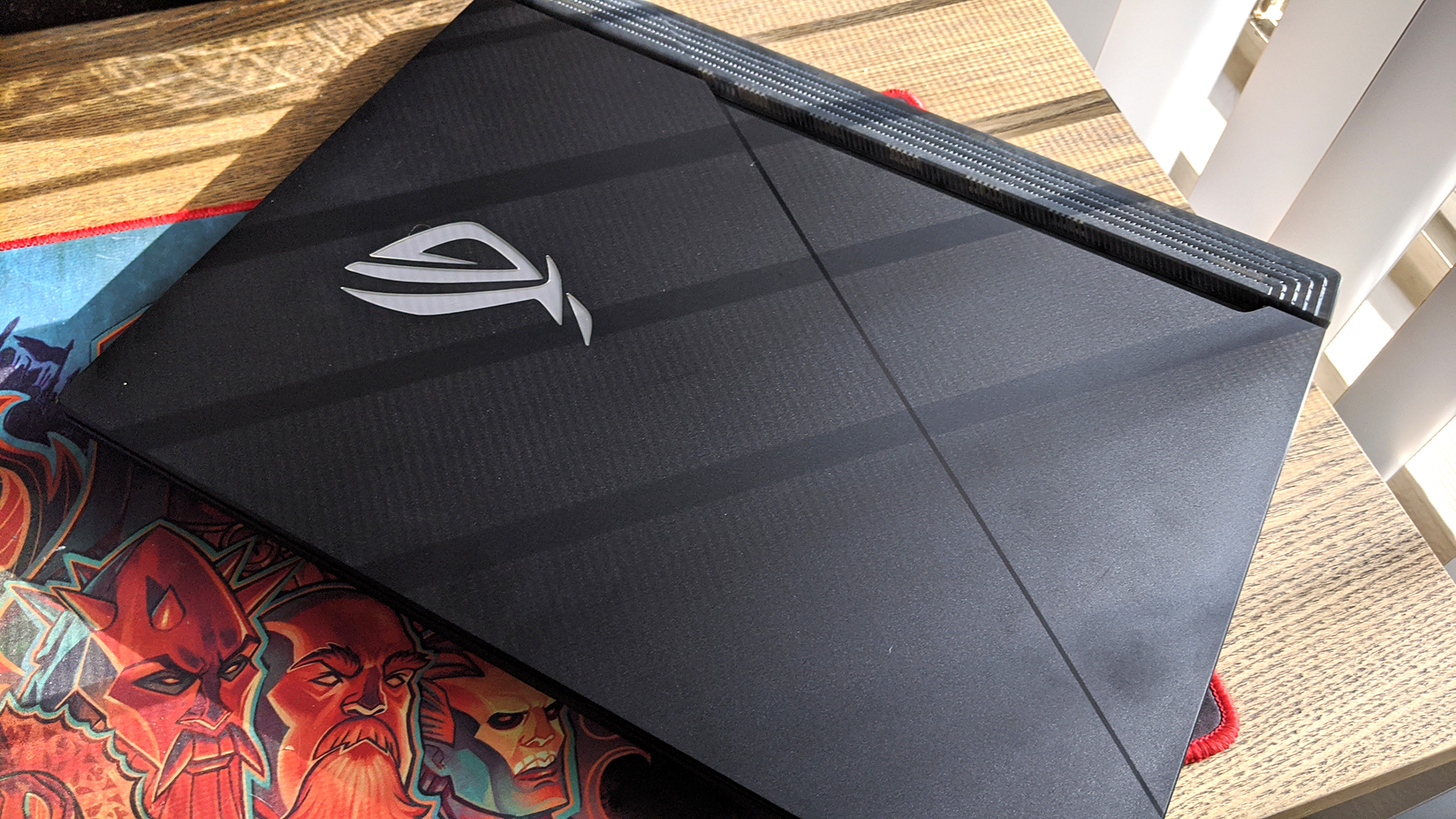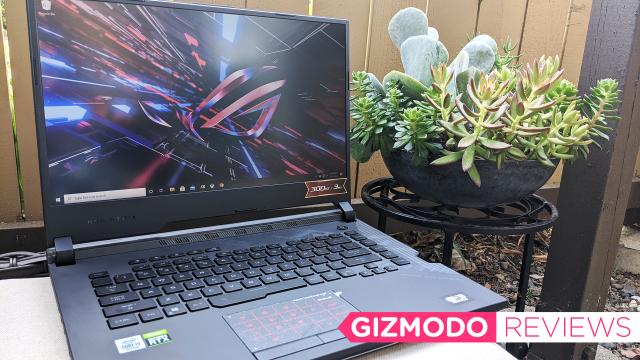There’s a race starting in the gaming laptop space — or rather a race that started a while ago, but its been moving at the pace of a baby’s first steps. That race is to make the thinnest, lightest gaming laptops without sacrificing performance. As of now, that seems nigh impossible for the most part, even with a Max-Q graphics card. More performance means more heat, so higher-end laptops are generally thicker and have fans that sound like a 747 revving up for its runway sprint. The slimmer and lighter laptops don’t need such extreme cooling measures because they don’t have enough power to generate that much heat. With that in mind, the Asus ROG Strix Scar G15 isn’t the bulkiest gaming laptop around, but it’s got some meat to it to contain all that power and a brutal $US2,800 ($3,853) price tag.
Coming in at 3 kg. and 14.2 x 10.8 x 0.8 inches, the Strix Scar G15 packs a full RTX 2070 Super and an Intel Core i9-10980HK inside, so that’s enough justification for its size. It needs breathing room, and you’ll see why in a bit once I get into the benchmarks. Sure, it’s not the smallest of the Asus gaming laptops, like the Zephyrus G15 that weighs 2 kg., but it’s not the largest either, like the ROG G703 that weighs 5 kg. Try carrying that monster around in a shoulder bag or backpack. No thanks.
The Strix Scar G15 is small enough, even though its fans do sound like that airliner at takeoff when in performance or turbo mode. But that’s the trade off we’re stuck with at the moment. If you want to squeeze out every last frame, it has to be loud.
Aesthetically, the chassis design isn’t totally my favourite: the back vent sticks out about an inch, the display hinges are bulky, and there are straight grooves on the right side of the keyboard that are there just for decoration. An RGB lighting strip hugs the base of the chassis like a Fast and the Furious car outfitted with neon lights on the undercarriage. There’s a sort a menacing quality to it that screams “Wanna go fast?” and it sure does live up to the reputation it exudes. Asus worked in collaboration with BMW to design the Strix Scar G15’s look, so I shouldn’t be surprised.

Asus ROG Strix Scar G15
What is it?
One of Asus' latest gaming laptops with an Intel 10th-gen processor.
Price
$US2,800 ($3,853) as configured
Like
300 Hz display, solid keyboard, performance
No Like
Chassis design, price, no webcam
The keyboard is one of my favourite laptop keyboards I’ve been able to test in the last few months though. It doesn’t have the same clicky responsiveness as Gigabyte’s Aorus 17G, but the linear press feels firm and steady under my fingertips. This is also the first time I’ve gotten to try Asus’ integrated number pad with the trackpad, and I was pleasantly surprised at how responsive that was. A full-sized keyboard is nearly always a requirement for me, laptop or desktop, but the numberpad-trackpad on the Strix Scar G15 is a nice compromise — especially to keep the chassis as small as possible.
Where other gaming laptops like the Razer Blade Pro 17 can get too hot to touch in certain areas, the majority of the surface around the ROG Strix Scar G15’s keyboard remains pretty cool, under 48°C. That’s pretty remarkable considering how hot the CPU gets. According to HWInfo, max CPU temperature after gaming on ultra for just 10 minutes was 98°C. The frequency never went above 5.1 either, which means one of Intel’s special frequency-boosting algorithms never kicked in because the CPU was too hot. The boost will give the CPU up to an extra 200 MHz if the CPU temp is 65°C or below, and up to an extra 100 MHz if the CPU temp is 85°C or below. And while I didn’t detect any thermal throttling with my eye, HWInfo sure did.
One of the more interesting aspects of this laptop is that it uses a liquid metal compound (usually made of mostly Gallium) instead of traditional thermal paste or a thermal pad in between the CPU and heatsink plate. It’s better at conducting heat, and considering how hot the Core i9-10980HK seems to get, it’s probably a good thing the ROG Strix Scar G15 uses liquid metal instead of paste.
But enough about thermals and airflow and design — how does the Strix Scar G15 perform? For a $US2,800 ($3,853) gaming laptop, it’s one of the best we’ve tested recently. The single-core benchmark in Geekbench 4 broke 6000 (6070 to be exact), and the multi-core benchmark was 34131. This is up there with the desktop Core i9-10900K. The Strix Scar G15 is also decently speedy in both Blender CPU/GPU and Handbrake tasks. Rendering a 3D image in Blender took a little over seven minutes for both CPU and GPU rendering. Transcoding a 4K video to 1080p 30 fps in Handbrake took the same amount of time as well. If gaming is not your thing, this would make a good laptop for media work.
But gaming-wise, this laptop shreds. At 1080p ultra (or highest graphical settings), the Strix Scar G15 spat out an average of 110 fps in Far Cry 5, 80 fps in Total War: Warhammer II, 99 fps in Shadow of the Tomb Raider, 64 fps in Metro Exodus with ray tracing off, and 51 fps with ray tracing on. Frame rates in Overwatch got as high as 255 fps, so not quite the 300 Hz display limit, but now that I’ve spent more time with 300 Hz displays, I’m starting to think a higher refresh rate does improve my aim a little bit. (Or maybe I’m just delusional.)
Looks and loud fans aside, there’s a lot to love about the Strix Scar G15 but that $US2,800 ($3,853) price is a bit outlandish. Like Razer or Alienware branding, the ROG branding comes at a premium. Unless you are a serious FPS player and need the 300 Hz screen and high-end components, the Strix Scar G15 is probably not your speed. Something like the Zephyrus G15 or M15, or Zephyrus S costs about 50% less and is better suited for 1080p gaming up to 144 Hz. If you absolutely must have higher-end parts in your laptop, you might want to consider the MSI GS66 Stealth or the Acer Predator Triton 500. They’re still not cheap, but are cheaper with near-identical performance, and they have a better, more subtle design too.
If you don’t care about the design, at least take the nightmarish CPU temps into consideration. Sure, the keyboard is nice and the performance is great, but since you probably won’t see clock frequencies higher than 5.1 GHz, you’re better off going for a model with a Core i7-10875H.
Temps are only a bit lower, as that SKU and like the i9 in this laptop, it has 8-cores/16-threads. Plus you’ll be saving money. Alternatively, you can opt for a gaming laptop with a Core i7-10750H. 6-cores/12-threads and a max boost of 5.0 GHz, paired with the same GPU, is still plenty of performance for the majority of games, and I haven’t seen the same thermal issues with that CPU model that I’ve found with the i7-10875H and this i9. If you are ok with sacrificing some frames or adding a few minutes to the 3D rendering time, you’ll be getting a better, all-around laptop than the Strix Scar G15. It’s powerful, but not really practical.
README
- Good cooling, even if the fans are really loud
- Solid keyboard and neat number pad integration with the trackpad
- The angular chassis design is not my cup of tea
- No webcam, but there is an Ethernet port
- So expensive!
